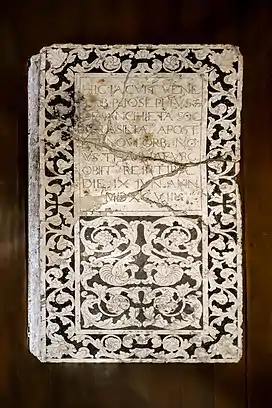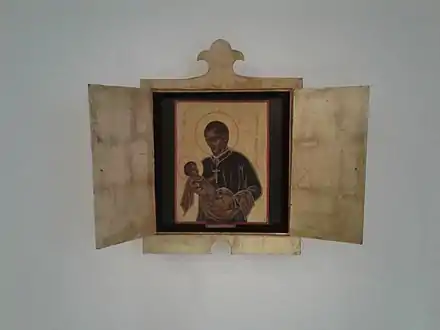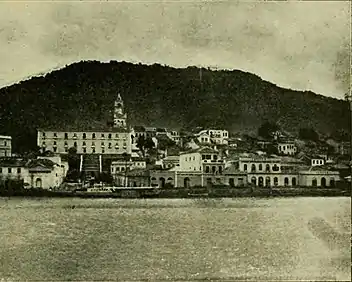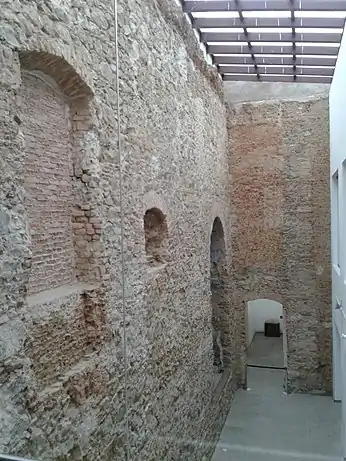Anchieta Palace (Espírito Santo)
Anchieta Palace is the seat of the executive branch of the state of Espírito Santo, Brazil. The palace is located in the city of Vitória, directly in front of the Port of Vitória, at the entrance of Cidade Alta, one of the oldest neighborhoods in the city. the palace has been used as the seat of the government of the State of Espírito Santo since the 18th century, being one of the oldest government headquarters in Brazil.
| Anchieta Palace | |
|---|---|
Palácio Anchieta | |
 | |

| |
| Former names | Church of St. James College of Saint Mauritius Presidential Palace |
| General information | |
| Location | Espírito Santo |
| Town or city | Vitória |
| Country | Brazil |
| Construction started | 1551 (First Church of St. James) |
| Completed | 1935 |
| Owner | Government of the State of Espírito Santo |
| Design and construction | |
| Architect | Afonso Brás Justin Norbert |
History
In the year 1551 the newly created Village of Our Lady of Victory suffered the beginning of large constructions. The priests of the Society of Jesus, led by Father Afonso Brás, began the construction of the architectural complex formed by the Church of St. James and the College of the Jesuits. current Anchieta Palace.[1] Father Afonso Brás describes on August 24, 1551 his arrival in the captaincy of Espírito Santo and the work undertaken:
From Porto Seguro to Espírito Santo there are sixty leagues. When we arrive, the residents welcomed us with great pleasure and joy, and since I arrived until Easter, I didn't care or understand anything else, if not to confess and make a poor home, so we can retreat into it; it is covered with straw and without walls. I will work to build a chapel next to it in a very good location, in which we can say mass, to confess, preach doctrine and the like. (...) We preach the doctrine every day to the slaves of this village, who are many. (...) It is this land where I am at present the best and most fertile in all of Brazil.[2]
In 1570, a fire destroys the first headquarters of the Church of St. James. Mobilized by Father Inácio de Tolosa, missionaries in gratitude for the welcome after a shipwreck at the mouth of the Rio Doce started building a new headquarters for the Church of St. James, now in stone, in the same location as the previous one, after drilling an 8-meter well behind the church.[3]
The House of St. James, in the form of a college and seminar, was for more than two hundred years the beacon of education in the province of Espírito Santo.[4]


Among the illustrious characters who passed through the complex was Father Joseph of Anchieta who, in 1587, was responsible for directing and completing the first wing of the St. James College facing John Climacus square and the church of Our Lady of Conception in Anchieta. Due to his duties he established himself in Village of Vitória as Superior. From 1592 to 1594 he was appointed Visitor of the houses of the South. In 1596, he was appointed governor and councilor of Vitória's House. Subsequently, he was able to leave his duties and retired to Reritiba, where he died on June 9.[5] He was buried in Vitória, in front of the main altar of the old church of St. James, where even today it is possible to visit the symbolic tomb, because in 1610 the remains were removed to Bahia.[6]
The Church of St. James, inaugurated at the beginning of the year 1552, built next to the school house, had enough space for liturgical services and accommodation for religious. In 1666, the church structure threatened to collapse and underwent a remodeling process, a procedure that made the church look like a new construction.[7]
In 1707, the second wing of the college was built facing the bay of Vitória and in 1734 the third wing was built, closing the inner courtyard, next to the second tower of the church.[3]
In 1727, the roof was restored and the walls supported. In 1747, the fourth wing is built, adjacent to the church, forming a quadrilateral.[3] In 1757, with the expulsion of the Jesuits from the Portuguese colonies, the goods belonging to the clergy, as well as the Jesuit complex of St. James, were incorporated into the national heritage.[8] In December 1759, Vitória witnessed the arrest of the Dean of the college and 5 priests.[9]

In 1796, another major fire destroyed the interior of the temple, including the image of St. James. The images of St. Ignatius of Loyola and St. Francis Xavier that were part of the altar were transferred to the church of Saint Gonsalo. Only in 1798, two years after the fire, the building was recovered and called the Government Palace.[10]
In 1860, the palace is undergoing renovation works and receives the emperor Dom Pedro II and the empress Dona Teresa Cristina Maria. They remain in the state for 15 days.[3]
During the administration of Jerônimo Monteiro (1908-1912), the palace, a former church, underwent major renovations. The set underwent major changes and received a new architectural garment with eclectic characteristics that were very popular in the early years of the 20th century and spread by modernists.
The works were in charge of the French engineer Justin Norbert, who was also responsible for the construction of the capixaba market no centro da capital. The original roof was raised, the facades were remodeled and a new opening is made towards the Bay of Vitória.
The church of St. James was purchased from the Bishopric on November 23, 1911 and attached to the palace building, an old space used as a home and college.[11] The tower on the right was demolished in the first major renovation and the second in 1919, under the government of Bernardino Monteiro.[12]
In 1945, the Palace was officially named Anchieta, in honor of the priest, by means of decree No. 15,888 signed by Governor Jones dos Santos Neves.[6]
In 1983, the building was listed by the State Council of Culture and in 2004, the first major restoration work began, which was only completed in 2009.[10]
About the palace

As the palace was a Church, during reforms, bodies were found (probably from Fidalgos) on the grounds.
For being a building of Jesuit origin, and the Saint Anchieta, that gives the building its name, have been one of your guests, the building has a relic of the saint, a piece of your Tibia.
It is the only Jesuit construction that in the colonial period had 2 bell towers and 1 clock. With its imposing quadrilateral, it was for many years the largest construction in the State of Espírito Santo and one of the 4 buildings in Brazil that have the Sgrafito technique, a 16th-century Moorish technique.
He currently has works of art with priceless values, heritage of the State of Espírito Santo.
References
- A Gazeta Journal. September 26, 1994.
- SANTOS, Estilaque Ferreira dos. History of the Municipality of Vitória: the acts and the minutes. Vitória: Vitória City Hall, 2014; (V. 1 - The trajectory of one of the first chambers in Brazil): p 35.
- "Anchieta Palace celebrates 460 years". SECULT (in Portuguese).
- Neida Lúcia Novaes. Magazine of the Historical and Geographic Institute of Espírito Santo. Vitória, Nº 44, 1994.
- "Who was St. Joseph of Anchieta?" (in Portuguese). Editora Cleófas. May 17, 2018.
- "Anchieta ghost haunts ES government headquarters, legend says" (in Portuguese). G1 ES. April 1, 2014.
- Moraes, Neida Lúcia (2002). Espírito Santo - História de suas lutas e conquistas.
- "The instruction after the expulsion of the Jesuits – By Serafim Derenzi". Morro do Moreno. March 14, 2017.
- "Expulsion of the Jesuits - By Mário Freire". Morro do Moreno. June 19, 2015.
- "Government of ES - Anchieta Palace". www.es.gov.br (in Portuguese).
- "Restoration work for the Anchieta Palace inaugurated on Thursday" (in Portuguese). Archived from the original on 2018-08-12. Retrieved 2020-02-03. Cite journal requires
|journal=(help) - Dias, F. V. Jesuit courtyard at Anchieta Palace: type-morphological and landscape narratives in the city of Vitória (ES). Dissertation (Master in Architecture and Urbanism) – Arts Center, Federal University of Espírito Santo. Vitória, p. 167-169. 2014.